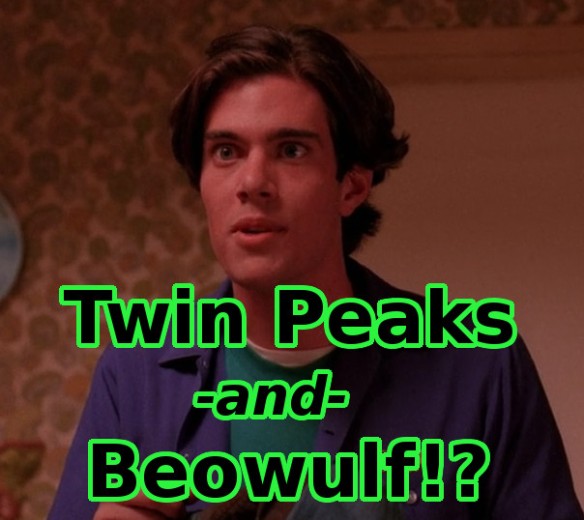
We can all share in Bobby’s shock. Image from http://www.gramunion.com/robotbeowulf.tumblr.com/155345786712
Spoilers abound below. If you’re not done with Twin Peaks The Return (or the entire series) just yet, read on at your own risk.
Introduction
It’s human nature to see patterns where there might not be any. It’s also human nature to want to combine the things you love even if they don’t seem likely to mix. That’s where today’s post is coming from.
Having seen and mostly digested Twin Peaks The Return, and being quite familiar with Beowulf, I noticed a few similarities. Especially when it comes to the monsters featured in both works.
Now, I don’t think that these similarities point to any answers in the Twin Peaks universe. Nor do I think that David Lynch is a secret Beowulf fan who wanted to work through the poem’s themes and motifs in his own art. I just noticed that there are some similarities between the oldest piece of English literature and the newest piece of television art.
And I want to share them with my readers.
This comparison will go through the monsters of Beowulf since that’s where the meat of this is. Though a case could be made that Lynch’s at times directionless-seeming storytelling is quite similar to Beowulf‘s asides and loosely related side stories.
There is one Twin Peaks theory at work in this comparison. This is the idea that the ancient evil force that Gordon Cole calls Judy in part 17 of The Return is the same as The Experiment that we see in parts 1 and 8.
Now, let’s get right into those monsters!
The Monsters in General

Beowulf battles Grendel in Santiago Garcia and David Rubin’s Beowulf. Image from http://bit.ly/2jVrgOn.
Beowulf features some sort of unidentified troll-like monster, its mother, and a dragon. Twin Peaks has two monsters, essentially: Killer BOB and Judy (Jao De). I’m not sure how evil spirits from other dimensions or outside of time trace their lineage, but I think it’s safe to say that Judy is Killer BOB’s mother. So there’s one parallel.
But there’s more to the Beowulf–Twin Peaks monster connection than mere surface similarity.
Like Grendel and his mother, BOB and Judy are encouraged by human action. In the case of the Grendels, the construction of Heorot disturbs them and provokes Grendel to attack. Heorot, however, is no military barracks but a place meant for peaceful gatherings and where new friendships could be forged or old ones strengthened. For BOB and Judy, the human action that gets them into action is the nuclear testing at the Hanford site. A nuclear bomb is not really much like a drinking hall, though it is interesting to think about it in terms of its ultimate goal: to ensure, through either use or mere presence, the continuation of peace. As part of this comparison,
I think it’s also neat to think of the hall, a place of peace, inciting the Grendels in a world rife with everyday conflict, whereas the bomb is a weapon of destruction in a world that enjoys everyday peace.
Grendel/Killer BOB
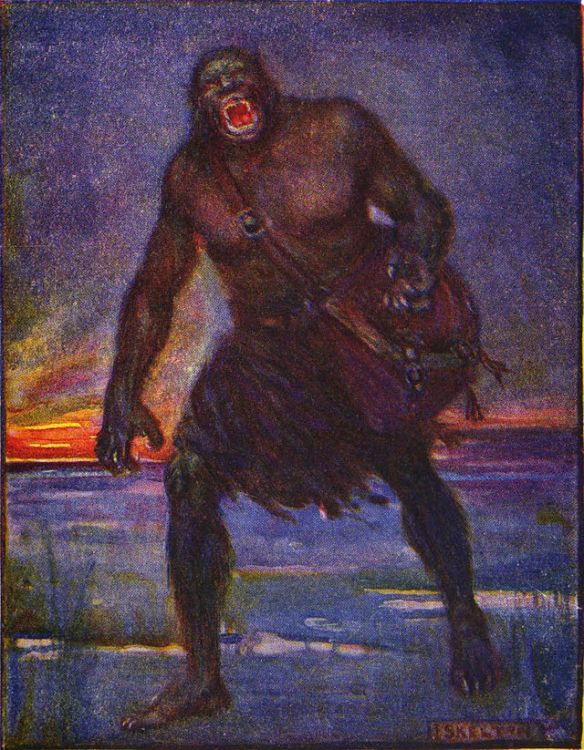
An illustration of Grendel by J.R. Skelton from Stories of Beowulf. Grendel is described as “Very terrible to look upon.” From: https://commons.wikimedia.org/wiki/File:Stories_of_beowulf_grendel.jpg
Moving on from that rabbit hole, though, we come to Grendel as an agent of terror. Likewise, BOB terrorizes those he inhabits and the lives of those around his hosts. Also, how Grendel and how Killer BOB are defeated is similar.
In Beowulf, the poem’s hero wrestles Grendel into submission with his bare hands. He even goes so far as to tear off the monster’s arm with just his hands since his grip has the strength of 30 men. In Twin Peaks something similar happens: Through a strange sequence of events Freddie ends up buying and putting on a green gardening glove that lets him punch with the power of a pile driver. This strength overcomes Killer BOB when he’s in his ball form, shattering him to pieces.

The arm.
Those pieces, like Grendel in the poem, then run away. And it seems likely that after the events of part 17 of The Return, BOB is as dead as Grendel is by the end of Beowulf.
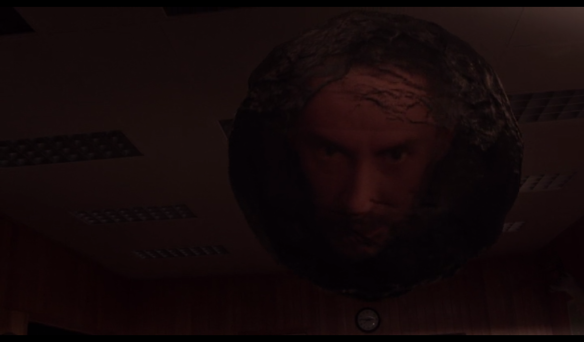
The BOB bubble that Freddie bursts.
Grendel’s Mother/Judy
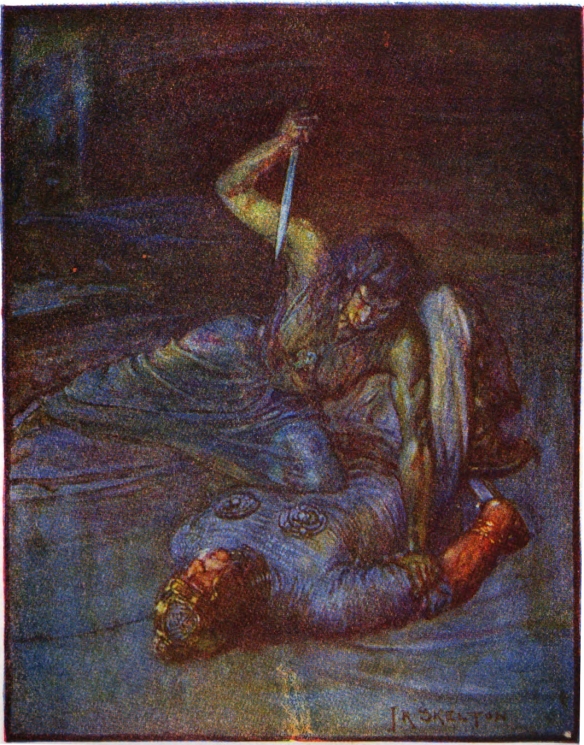
By J. R. Skelton – Marshall, Henrietta Elizabeth (1908) Stories of Beowulf, T.C. & E.C. Jack, Public Domain, https://commons.wikimedia.org/w/index.php?curid=11001837
Grendel’s mother also shares general traits with how Judy operates. When Grendel is killed Grendel’s mother shows a level of calculated intelligence when she only kills and carries off one of Hrothgar’s men. Not only does this action show that she has a concept of “an eye for an eye”, it suggests that she is aware of the nature of feuds.
Judy, a being of supreme evil, operates with similar careful calculation. She does not just let Cooper walk Laura to the white lodge when he plucks her from death in the original timeline/dimension of the series. Instead she plucks her away from him and brings her to another timeline/dimension entirely. But Judy doesn’t just hide Laura anyway. She brings the girl to a place where she holds sway (and runs a coffee shop apparently).
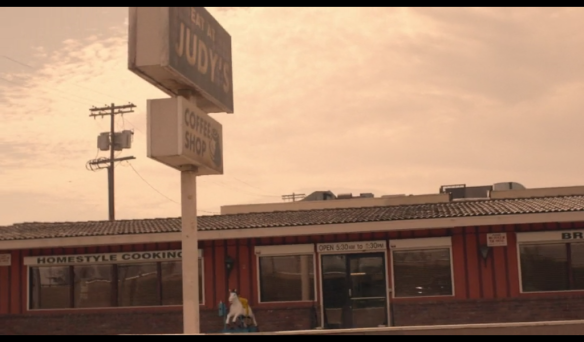
Judy’s has it all — breakfast, homestyle cooking, and a slick white horse ride.
Cooper ventures into the place that Judy has made, where she seems to have some sort of dominion in an effort to get Laura back. Similarly, Beowulf dives into a lake to get to the Grendel’s underwater hall where Grendel’s mother holds power.
Heroes’ journeys to strange places to face powerful foes isn’t anything all that new or rare in stories. But I find it fascinating that both heroes venture into what is essentially enemy territory in similar ways. Beowulf dives until the currents pull him into a strangely lit cavern. Cooper travels down a road until he passes under electrical lines and ends up in this strange, yet familiar, new place.
Further, Beowulf goes into his trial with the sword of the enemy-turned friend Unferth. Cooper goes into it with a friend whom we’ve seen as being untrustworthy and manipulated throughout the season in Diane. In both cases, these helps prove useless in the confrontation with the power that they are fighting. Unferth’s sword does no damage to Grendel’s mother, and Diane forgets who she was as she settles into her new role as Linda in this new timeline/dimension.
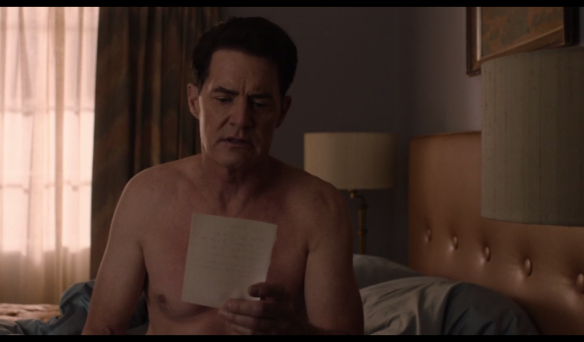
Cooper reads Linda’s weird note.
The Dragon/The Experiment/Judy
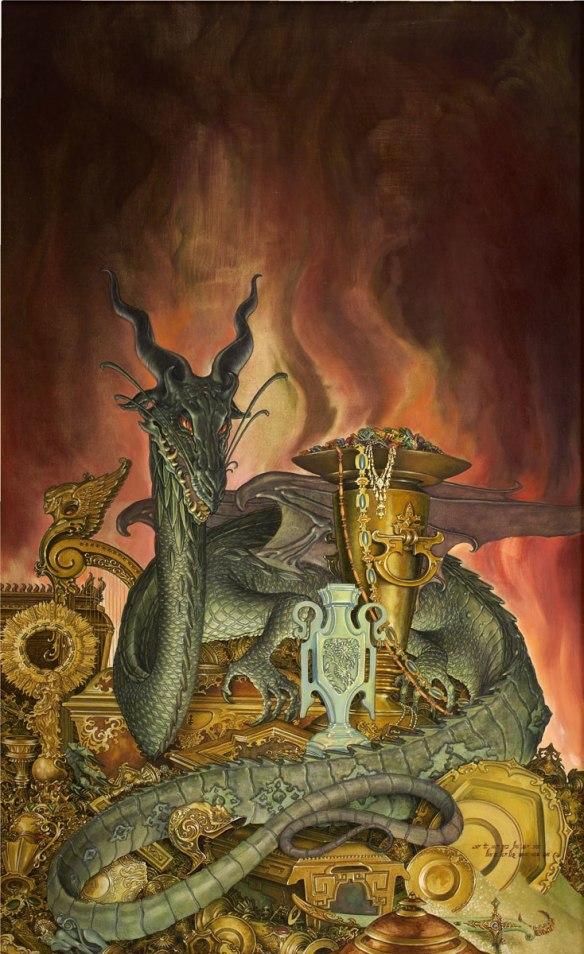
A dragon and its hoard.
Now, there is no dragon in Twin Peaks. Something so blatant or obvious just isn’t David Lynch and Marc Frost’s style. But. I think that there are more similarities between Beowulf‘s story and Twin Peaks The Return‘s main conflict. Though they require some mental squinting to see.
Up until the end of The Return, what exactly the vaguely female creature credited as “Experiment” was was unclear. I think it’s fair that this creature fits the role of Grendel’s mother quite perfectly. But. I also think that this creature fills the role of the dragon as well. She doesn’t transform into some sort of giant scaly creature for Cooper to shoot at or anything like that, but what the Experiment comes to be by the end of The Return is on the same level as the dragon in Beowulf.
In the poem, the dragon is not just the final foe that Beowulf faces. It is an ancient thing, greedy and prideful, that starts to terrorize Beowulf’s lands when one of its treasures is stolen. Of course, this dragon doesn’t spend any of its treasures, it merely hoards them. It is the inspiration for the vain and greedy Smaug from the Hobbit. Likewise, Judy seems to hoard whatever those bubbles that she and The Fireman sent out around the mid point of The Return. Once she wins them over to her pile that is. As she does with Laura.
I think that Judy is much more than the vaguely female shape we see in parts 1 and 8. The Experiment, with its ability to blend people’s faces faster than a Blendtec mashes diamonds, is just an embodiment, just a shell. It could be argued that that isn’t even correct, and the Experiment as Judy is merely a perception of the kind of evil force that simply cannot be embodied.
In short, Judy is bad news.
In Beowulf the dragon is bad news.
It burns down Beowulf’s meeting hall, terrorizes his people, and threatens their very existence. Just like Judy in the Twin Peaks universe.
But, just like the dragon, I think that Judy only flexes its true muscle, shows off its true power as an evil force, when its most prized possession is stolen away from it. When Coop saves Laura from ending up in plastic on the beach in Twin Peaks, it’s like someone just stole something from the dragon’s hoard. From that moment on in The Return, I think that Judy transcends (if that makes sense) into its true self and is able to create all new realities (timelines/dimensions) in which to hide Laura.
Meanwhile, having passed through the lodge twice now, Cooper is somehow older, perhaps more wizened. This comes across in the diner scene where he takes down the three cowboys. Yet, he warns the fry cook that the oil he just dropped the cowboys’ guns into may be hot enough to set them off. Like Beowulf when the dragon attacks, this is an older, more tired hero that we’re looking at. Yet he is certain of himself and confident enough to find Carrie Paige (Laura), bring her back to Twin Peaks, and try to remind her of who she really is. Just as Beowulf is confident enough in his own abilities to fight the dragon.
Both stories then end.
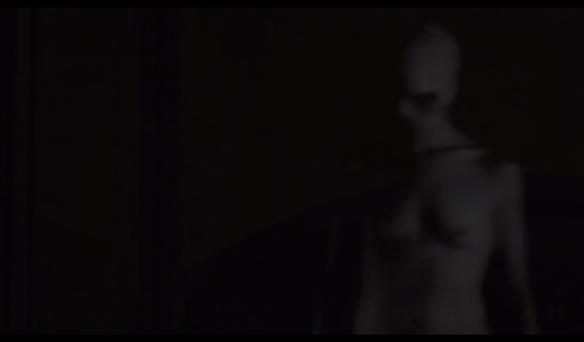
The eerie Experiment from the glass box.
Conclusion
With Beowulf, the dragon is defeated but Beowulf is mortally wounded. And the future of the Geatish people, and the whole way of life that the poem portrays, is unclear.
With Twin Peaks, Carrie Paige remembers who she is, and Cooper seems to wake up — which should be a victory. But instead we hear the same scream that filled the woods when Laura was swept away from Cooper earlier in the episode. We then hear a faint ethereal “Laura” and the electricity flickers. The house where Laura lives goes dark. Then the entire screen goes dark.
Thematically, these endings have much in common. Both are bittersweet, yes. But more than that both endings demonstrate the ending of something incredible. Whether the Geats survive without their king, or whether Cooper and Laura triumphed over that wave of evil they were up against are unclear. Both are unwritten. But both are certainly art.

The dimmed Palmer (?) house.
And that’s my attempt to bring these two disparate bits of media together. An early medieval epic poem and a surreal detective/supernatural television show. To me it all makes some kind of sense.
But what do you think about this comparison? Is it even possible to compare two things that are so different in time and place and content? What are your own pet theories about the ending of Twin Peaks?
Share your thoughts in the comments!

Pingback: Welcome to the Wordhoard! | A Blogger's Beowulf
Nice NorsePlay! A few weeks before you posted this, I posted some more generalized Norse Lore parallels beyond Beowulf here: https://norseplay.blogspot.com/2017/08/david-lynch-meditates-into-norse.html . But yeah, great minds.
Also, outside of the Lore as a detailed The Return wrap up on the night the show ended, I wrote this on my other blog: https://guillermotheivth.blogspot.com/2017/09/twin-peaks-resolution.html . And I didn’t notice the diner was called Judy’s, so good catch!
LikeLike